Bullish Asian gas demand forecasts eroded by renewable surge
Increased momentum in the energy transition has led the IEA to reduce its gas demand forecast for 2040 by 1,500…
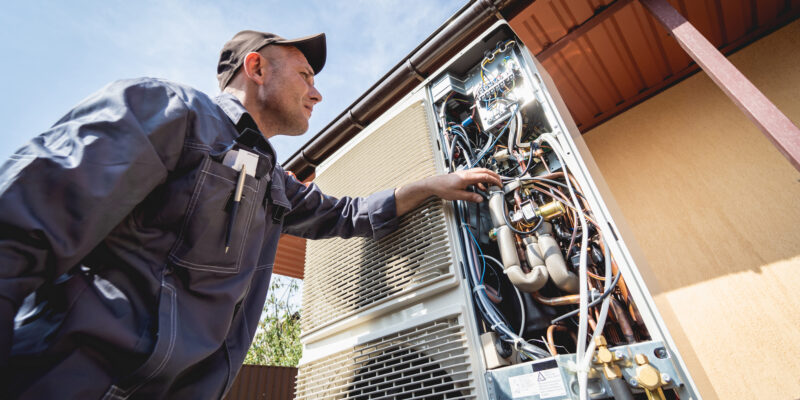
A heat pump is an electrical appliance that can be used to replace a fossil fuel-based heating system. When run on clean, renewable electricity, they reduce emissions and protect consumers from fluctuating fossil fuel prices. Heat pumps can be used to warm or cool a building, heat water, or produce low and medium-temperature heat for industry. They can be effective even in very cold climates – cold-climate heat pumps are still able to heat a building in weather conditions down to about -30°C.
Unlike some other low-carbon technologies, heat pumps are not new – they use the same technology used in fridges and air conditioners. It was first demonstrated in the mid-1700s, and heat pumps were first installed in buildings in Switzerland in the 1930s. Inside a heat pump, a gas called a refrigerant absorbs heat from one location, is compressed to increase the heat, before the heat is released in another location (for a more detailed explanation of how heat pumps work, see Box 1).
There are three main types, which are designed to absorb heat from different places:
Heat pumps come in various forms – a heating unit with fans, a water-based distribution system (like radiators) or a ducted ventilation system. They can also be used for hot water, either by retrofitting an existing hot water tank or by combining a heat pump and water heater. Excess heat from the pump itself can even be used to provide instant hot water.
Heat pumps can also cool buildings, and rising global demand for cooling presents an opportunity for increased uptake. In cooling systems, a heat pump works the opposite way, removing heat from inside a building and dumping it outside. Reversible heat pumps that provide both heating and cooling are also available.
All heat pumps have the same basic mechanism – they absorb heat from a cold location (a source – e.g. the outside air) and release it into a warmer location (a sink – e.g. the inside of a building). The system is powered by electricity, meaning that when run on renewable power, heat pumps are the best clean energy alternative for space heating in most environments.
Heat pumps contain a gas called a refrigerant, which is much colder than the air or ground, and this passes through a vapour-compression cycle. Heat (thermal energy) from the air or ground is absorbed by the cold refrigerant in an evaporator, warming it up. The high-energy refrigerant gas is then compressed, making it even hotter, and pumped into a building where it releases heat via a condenser. The refrigerant is then allowed to expand, cooling it and bringing it back to the start of the cycle.
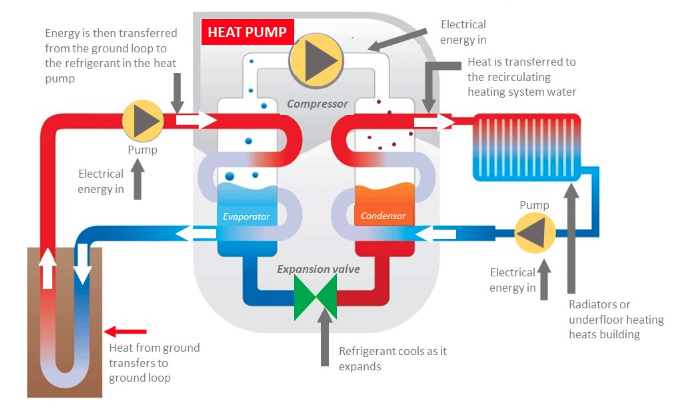
Heat pumps can be powered with renewable electricity, dramatically reducing emissions compared to fossil fuel-based heating.
Taking into account the current energy mix in the power system, operating an air-source heat pump already produces fewer emissions than the most efficient condensing gas boilers in North America, Central and South America and the Asia-Pacific region, according to the IEA.
Heat pumps are very efficient, with an energy output several times the amount of energy put in. A typical household heat pump has an energy output four times greater than the energy (electricity) needed to run it.[1]The coefficient of performance (COP) of a heating appliance is the ratio of energy used to heat produced. An average household heat pump has a COP of 4, meaning it produces four units of heat for … Continue reading This makes heat pumps three to five times more efficient than gas boilers, and around four times more efficient than conventional electric heaters. This is because the heat provided by a heat pump is absorbed from its surroundings, rather than produced. The exact efficiency of a heat pump depends on the type of pump, the climate and source of heat.[2]The larger the difference in temperature between the source of heat and where it is released (the sink), the more energy a heat pump uses to move the heat.
Other technologies for clean heat are not fully developed and remain more expensive than heat pumps or carry other risks. The technology for clean hydrogen heating is not yet available – hydrogen is currently made using fossil fuels, risking locking-in fossil fuel use for heating – and will be more expensive and less efficient than heat pumps, as well as carrying a risk of explosions. Biomass heating emits dangerous pollutants that are harmful to health. Solar thermal systems are another option for clean heat, but these generally need to be used alongside another heat source.
The IEA considers heat pumps to be “the cornerstone of sustainable buildings”, a technology that will play a fundamental role in decarbonising space heating and cooling, alongside energy efficiency measures. Buildings account for around four gigatonnes (Gt) of direct CO2 emissions annually – around 10% of total global CO2 emissions (see chart below). Over half of this is direct emissions from space and water heating.[3]In 2021, space and water heating resulted in 2.45 Gt of direct CO2 emissions, 60% of this from gas, 27% from oil and 14% from coal.
If all governments meet their energy and climate targets on time, heat pumps will produce nearly 20% of heat in buildings in 2030 – double that of today – with capacity growing in all regions. In this scenario, heat pumps will account for half of the reduction in fossil fuel use for building heat by 2030, and energy efficiency for the other half.[4]According to the IEA’s Announced Pledges Scenario (APS), in which governments meet their announced energy and climate related pledges in full and on time.
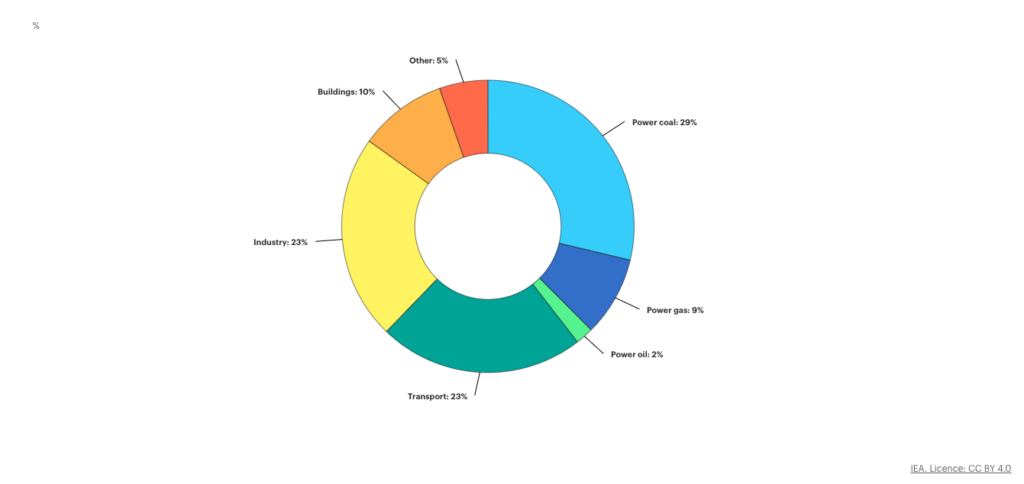
Industry is responsible for 23% of global energy-related CO2 emissions, with heat making up two-thirds of industrial energy demand. Estimates indicate that the heat pump technology available today could meet 10% of industrial energy demand, although the potential decarbonisation impact of heat pumps in industry varies sector-by-sector.
The greatest potential impact is in sectors with high demand for low-temperature heat, like the paper, food and chemical industries. Heat pumps are currently used in industry to produce low to mid-temperature heat (>160°C) for processes like bleaching and de-inking paper, or evaporating water to concentrate food. Heat pumps can also be used to capture and raise the temperature of waste heat, producing heat up to 160°C for processes like drying paper and food, and distilling chemicals. Alternatively, heat pumps can take waste heat to warm nearby buildings.
Heat pumps have been developed to produce heat up to 180°C and systems producing temperatures up to 200°C are under development. However, other clean energy technologies, such as direct electrification, currently offer more economical solutions for high-temperature heat. Clean hydrogen may provide a solution in the long term.
District heating networks are large-scale heating systems that provide heat to multiple homes or businesses through a network of insulated pipes carrying hot water. Today, they cover around 9% of heat demand, particularly in very cold regions, including the EU, Russia and China. However, the majority of district heating is still produced with fossil fuels – just under half is produced with coal and 38% with natural gas. Research has shown that district heating systems have the potential to meet half of Europe’s heating demand, with heat pumps powering up to 25% of these systems.
Electrical heat pumps can be used to retrofit networks that burn fossil fuels. Heat pump systems function at a lower heat than combustion systems, circulating water at around 45-60°C, which reduces wasted heat and improves overall system efficiency. District heat systems incorporating heat pumps can also make use of waste heat from nearby industry or businesses. For example, a district heating network in Vienna uses waste heat from the Therme Wien thermal baths. Water leaves the baths at around 30°C and a heat pump raises the temperature to 85°C, supplying heat to 1,900 households.
Different types of heat pumps collect heat from different places and can be used in different locations, depending on the climate, building density, existing infrastructure and geological features. The main categories are:
Air-source heat pumps currently dominate the global market, accounting for around 60% of sales in 2021. This type of system absorbs heat from the air, and can either be installed as a one-block system, where one unit both absorbs the heat and emits it, or a split system, where heat is absorbed by one unit outside and emitted by another inside. Air-source heat pumps are generally quicker and cheaper to install than other types. They don’t require much ground space and do not need to be close to water, so can be installed in apartment buildings or dense urban areas. These systems can be used in almost all climates, but work most efficiently in temperate climes where air temperature does not change significantly.
The second-most common type of heat pump is ground-source, which accounted for around 2.5% of heat pumps installed in the EU in 2021. These systems source heat from the ground, from either a vertical heat collector in a deep borehole or a horizontal heat collector laid in trenches and buried underground. These systems are more efficient than air-source heat pumps in areas with big changes in air temperature, as ground temperature remains more constant. Ground-source heat pumps are more expensive to install than air-source systems, due to the earthworks required.
This third type of system collects heat from water, like a lake, sea or underground water (ground water). Water-source heat pumps are especially efficient, as water is an excellent energy carrier, but can only be installed if the building is close to water.
Heat pumps can also be used alongside other clean heating technologies in a hybrid system. These are useful where a heat pump alone would be inefficient (or there is not enough space to install one big enough to make it efficient). In places where there’s a big temperature difference between the inside and outside, a very powerful and expensive heat pump would be needed to provide heat all year. Instead, a smaller heat pump can be installed, but swapped in for an electric heater on very cold days.
In the future, there is also the potential for hybrid heat pump-hydrogen systems. Hydrogen fuel cells are already being used in some countries, including Japan and South Korea, but heat pump and hydrogen boiler systems are still being developed. However, the IEA’s Net Zero Scenario foresees that hybrid heat pump systems for cold climates will meet no more than 5% of heating demand in 2050.
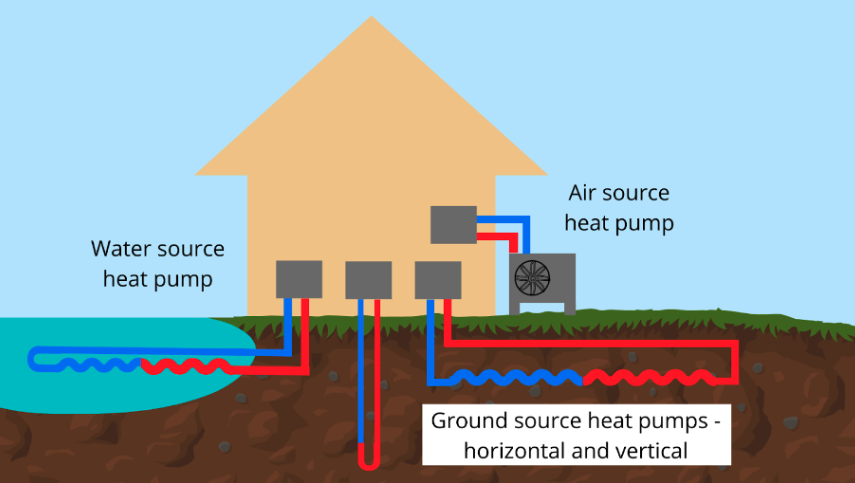
Heat pumps are set to be “the central technology in the global transition to secure and sustainable heating”, according to the IEA. Over the past year, the technology has received more attention as a way to reduce dependence on fossil fuels, especially natural gas in Europe, and to ensure energy security.
Heat pumps are already in use around the world – in 2021, 190 million were operating in buildings globally, meeting around 10% of building heating needs. In some countries, the technology represents a big proportion of heating appliances – 60% of buildings in Norway have heat pumps and 40% in Sweden and Finland.
Sales of heat pumps increased by more than 13% globally in 2021, with particularly high growth in Europe (35% year-on-year). In the first half of 2022, Italy saw 114% growth compared to the same period in 2021, while the Netherlands saw 100%, Poland 96%, Finland 80%, Germany 25%, Norway 11% and the US 7%. Meanwhile some countries have had relatively stable heat pump markets for decades, including Japan. Despite this, fossil fuel air and water heaters still accounted for almost half of all heating equipment sold in 2021.[5]This number dropped below 50% for the first time in 2021.
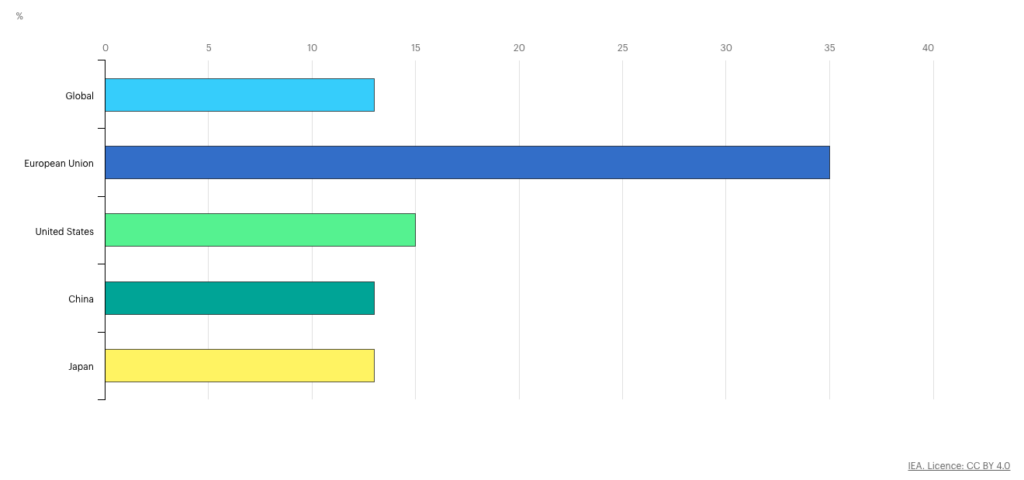
According to the IEA, heating a home with an air source heat pump works out cheaper over its lifetime (without subsidies and including up-front costs) than a gas boiler in the US, Korea, Japan, Italy and China, and marginally cheaper in Canada.[6]The levelised cost of heating (or cooling) is the average price of one unit of heating or cooling (in this case, 1 MWh) over the lifetime of the product. This price includes upfront costs and … Continue reading It is also cheaper than gas in the UK and Germany when subsidies are taken into account. These calculations were made in 2021, before the Russian invasion of Ukraine caused spikes in gas prices, which led to a rapid increase in energy bills.
Despite saving consumers money on heating over time, heat pumps are usually more expensive to buy and install than gas boilers which can deter consumers. Purchase and installation costs vary between countries, types of heat pumps, and according to the infrastructure and energy performance of the building – the heating system may need to be upgraded (see below). The unit costs for heat pumps are unlikely to go down at the same dramatic rate seen in other clean energy technologies, like EVs and solar PV, as the technology is already mature.
The local cost of electricity will also impact the cost of heating a home with a heat pump. In places where gas is cheaper than electricity, potentially because of government subsidies, heat pumps are less economically appealing. As a result, some clean heating policies include measures to make the price of electricity more competitive compared to gas.
Thanks to their technological maturity and existing use, it should in theory be easy to scale up heat pump production and rollout. However, there are a number of barriers that require policy support and new technical solutions to overcome.
A building must be well insulated for a heat pump to warm it efficiently. The better insulated the building, the less powerful the heat pump needed to heat it, meaning lower upfront costs, lower electricity bills and less strain on the power grid. The technology produces lower-temperature heat than gas boilers and is most efficient when left on all the time, meaning good insulation that allows heat to build up is paramount. In Denmark, heat pumps installed in houses with the highest energy efficiency rating (A+) have been found to consume 30 times less energy than those with the lowest energy efficiency rating (G).
Although new buildings can be built to the energy efficiency standards needed to operate heat pumps efficiently, heat pumps also need to be installed in existing buildings. In order to meet the REpowerEU goals, around five million will need to be installed in existing buildings by 2030 in Europe. This presents a greater challenge in countries where existing buildings are poorly insulated, like the UK. Similarly, existing district heating networks are designed to carry high-temperature heat, which is not suitable for integration with the low-temperature heat produced by heat pumps.
A resident who has decided to install a heat pump may also run into problems with local regulations, landlords or other tenants. In some regions, heat pump installation is subject to a lengthy or unclear approval process, especially if a ground-source heat pump involves digging or drilling a borehole.
A lack of skilled technicians trained to work with heat pumps is creating supply bottlenecks, for example in the EU. Expensive and non-standardised training schemes can be a barrier to workers becoming qualified. A study carried out in the UK found there is no clear training pathway for a career in clean heat, plus a lack of retraining incentives – either financial or in terms of clear career opportunities.
The forecasted rapid growth in heat pump rollout will require an increase in workers across the heat pump supply chain, and especially in installation. The same UK study estimated there are currently 3,000 heat pump engineers in the country, a number that will need to increase by 4,000-6,000 annually for the next six years for the country to reach its net-zero target. The IEA estimates that 450,000 people worldwide were already working with heat pumps in 2019, but if governments are to meet their pledges, employment in the sector will have to almost triple to more than 1.3 million workers by 2030.
Electrifying all sectors of the economy will contribute to an increase in total electricity demand. Some have questioned whether existing power grids will be able to sustain the additional burden, raising concerns about energy security, grid instability and blackouts. Electricity industry body Eurelectric estimates that updating the European and UK power distribution grids will require EUR 34-39 billion in investments each year between 2020 and 2030 – around 0.2%-0.3% of current EU GDP.
According to IEA estimates, if all current government pledges are met, heat pumps will contribute around 9% of the increase in electricity demand expected by 2030, and will only add moderately to peak energy demand in cold months. This impact can be limited if heat pump installation is paired with improving building energy efficiency, installing smart systems and grid planning that allows for flexibility. Heat pumps even have the potential to act as a demand-side response to help balance the grid – when used in combination with energy storage and smart systems, they can help balance grids by storing excess energy or reducing electricity demand at peak times. However, this application requires smart and integrated systems in well-insulated buildings, and as such is still in early development.
In countries where heat pumps are rare, a lack of information about their benefits and how to choose the right kind of pump can deter consumers. A study carried out in the UK found that although 90% of respondents felt that reducing CO2 emissions was important, many did not know that heating played a role in emissions reduction, while only a minority said they were aware of low-carbon heating technologies. Concerns around appearance and noise, installation works and learning how to operate a new system can also dissuade consumers.
In some countries, however, heat pumps have achieved broad public acceptance. In Norway, 60% of buildings have them installed thanks to decades of government support, high taxes on fossil fuels, low electricity prices and a 2020 ban on oil-powered boilers. Heat pumps need to be affordable and accessible for consumers to choose them. Increasing access to clear information about upfront costs, installation and how to use them efficiently can help sway consumer’s choices.
Heat pumps move heat energy by pumping a gas, called a refrigerant, around a closed system. Most heat pumps produced since the 1990s contain a hydrofluorocarbon (HFC), a type of fluorinated gas. HFCs are powerful, short-lived greenhouse gases producing a warming effect that can be thousands of times worse than that of CO2 over a few decades.[7]According to the Climate and Clean Air Coalition, the most abundant HFC is 3,790 times more damaging than CO2 over a 20-year period (CCAC). Exact global warming potential varies between different … Continue reading However, HFC gases are only emitted when heat pumps leak or are dismantled or destroyed without proper measures being taken to ensure the refrigerants are not released.[8]HFCs don’t destroy the ozone layer, as was the case with chlorofluorocarbons, which were banned in the 1980s and 90s. Other types of refrigerants are already being used in heat pumps and governments are making moves to limit HFC use.
Unlike some clean technologies, the challenge with heat pumps is not in technology development, but in implementing policies that both address the challenges outlined above and make the most of the opportunities available to encourage heat pump rollout.
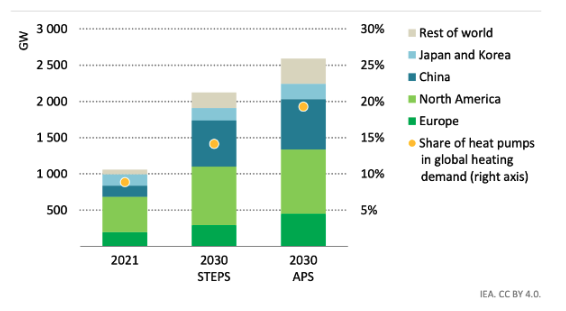
Because the technology is already well developed, the sector is unlikely to experience swift technological development that leads to a sharp drop in price, as was and is being seen with solar PV and wind power. However, producing more heat pumps will result in lower unit costs, while fiscal and financial incentives, such as grants, rebates and subsidies, can be used to reduce the upfront cost of a heat pump.
When gas prices are high, heat pumps gain a competitive edge, but high electricity prices raise operating costs and make heat pumps less appealing. Policy is needed to control electricity prices to ensure heat pumps remain competitive as gas prices fluctuate. Furthermore, carbon taxes or tax relief on electric power can help balance costs.
Governments are putting in place national climate policies that aim to reduce emissions from heating, many of which are combined with direct support for heat pumps. The most common policy support for heat pumps is fiscal or financial incentives. As of November 2022, 30 national governments offered grants for residential heat pumps, 24 offered low-interest loans, nine offered income tax rebates and five offered VAT rebates.[10]In many cases, this financial support is only available if existing fossil fuel heating is replaced. The 30 countries offering grants are responsible for almost three-quarters of global space heating demand.
This existing policy momentum was boosted by fluctuating gas prices and gas supply shortages, meaning governments are likely to continue strengthening policy to accelerate the heat pump rollout. In March 2022, the EU announced the REPowerEU plan, aiming to install 10 million heat pumps between 2023 and 2028 to reduce reliance on Russian gas. Germany and the Netherlands have announced bans on heating systems that run on 100% fossil fuels from 2024 and 2026 respectively, combined with improved training, scaling up production and financial support for purchasing heat pump systems (100% and hybrid). As of December 2022, 10 EU countries and the UK had a current or announced ban on some or all fossil fuel heating – all of which come into force before 2030.
Building codes, insulation regulations and clean heating mandates are also being used to encourage heat pump installations in new and existing buildings. France’s building energy code, which came into force in 2022, limits the emissions intensity of space heating and cooling. There are a few examples of heat pumps specifically being mandated for new buildings, including in Washington State (from July 2023). Such policies can take advantage of the natural replacement cycle of old heating appliances, as is the case for the UK’s boiler upgrade scheme.
In other regions, heat pumps are being encouraged through national and sub-national clean air initiatives and renewable energy targets. Through its 2017 Clean Heating Act, the Chinese government has encouraged the uptake of heat pumps in northern China to replace coal heating and improve air quality. Today, China is the global leader in heat pump installations.
In order to meet growing demand for heat pumps, governments and manufacturers will need to work together to expand production capacity. Governments are setting targets to scale up manufacturing – for example, the UK government’s Heat and Buildings Strategy sets aside GBP 450 million for subsidies to switch out gas boilers for heat pumps. It also aims for a thirtyfold increase in heat pumps manufactured and installed in the UK by 2030, with support for supply chains and industry. Manufacturers also announced plans in 2022 to expand production and open new manufacturing sites, including Mitsubishi in Turkey, Daikin in Poland and Panasonic in Czechia.
Meeting government targets for heat pump installation will also require a big push to train and reskill technicians to carry out the work. In the IEA’s announced policies scenario, the number of installers (around half of the heat pump workforce) will increase by 650,000 by 2030. Technical professionals from related fields, especially those working in fossil fuel heating, can be retrained to work with heat pumps. Research indicates that workers are willing to retrain as the new skills and expertise are needed and jobs involving fossil fuels come under increasing threat. New people will also need to be trained to enter the sector, particularly in regions where a significant proportion of the energy workforce is approaching retirement, including in the UK and US.
Governments and industry are working together to update certification and provide incentives for technical training and retraining. For example, the Dutch government announced it is working with the installation sector and manufacturers to ensure there is a training centre in every region. Pressure for installers can also be eased by standardising heat pump design and making them easier to install, reducing the need for extensive specialised training.
Current research and development aims to improve heat pump performance in different contexts and to reduce costs and environmental impact, as well as making them more appealing to consumers. According to the IEA, key areas for heat pump R&D are:
Another way of reducing the upfront cost of heat pumps is through innovative business models. These include heat-as-a-service (HaaS), in which energy suppliers sell heat as a ‘service’, usually for a monthly fee that covers the loan of heating equipment, maintenance and the amount of heat generated. Such models are increasingly being tested in Europe, with energy companies in Estonia, France, the Netherlands and Switzerland offering HaaS contracts in some form.
Other business models for heat pumps include:
Heat pumps can provide combined heating and cooling, or cooling or heating only. Therefore, the increasing global demand for cooling creates an opportunity to boost the rollout of heat pumps. In Europe, Japan, the Republic of Korea and the US, air-source heat pumps are already generally used for both heating and cooling. In the North of China, heat pumps are primarily used for cooling. Taking a combined approach to the two uses could also accelerate the rate of innovation, meaning more efficient appliances may be developed more quickly.
References
| ↑1 | The coefficient of performance (COP) of a heating appliance is the ratio of energy used to heat produced. An average household heat pump has a COP of 4, meaning it produces four units of heat for each one unit of electricity used. A standard electric resistance heater has a COP of 1 – it produces one unit of heat for every one unit of electricity used. |
|---|---|
| ↑2 | The larger the difference in temperature between the source of heat and where it is released (the sink), the more energy a heat pump uses to move the heat. |
| ↑3 | In 2021, space and water heating resulted in 2.45 Gt of direct CO2 emissions, 60% of this from gas, 27% from oil and 14% from coal. |
| ↑4 | According to the IEA’s Announced Pledges Scenario (APS), in which governments meet their announced energy and climate related pledges in full and on time. |
| ↑5 | This number dropped below 50% for the first time in 2021. |
| ↑6 | The levelised cost of heating (or cooling) is the average price of one unit of heating or cooling (in this case, 1 MWh) over the lifetime of the product. This price includes upfront costs and operating expenses. |
| ↑7 | According to the Climate and Clean Air Coalition, the most abundant HFC is 3,790 times more damaging than CO2 over a 20-year period (CCAC). Exact global warming potential varies between different HFCs – see the list here adapted from IPCC AR4 (2007). |
| ↑8 | HFCs don’t destroy the ozone layer, as was the case with chlorofluorocarbons, which were banned in the 1980s and 90s. |
| ↑9 | The IEA’s Stated Policies Scenario (STEPS) looks at the policies already in place today, assuming they are implemented. |
| ↑10 | In many cases, this financial support is only available if existing fossil fuel heating is replaced. |

Increased momentum in the energy transition has led the IEA to reduce its gas demand forecast for 2040 by 1,500…

Azerbaijan's climate and renewable energy efforts are dwarfed by its gas export expansion plans.